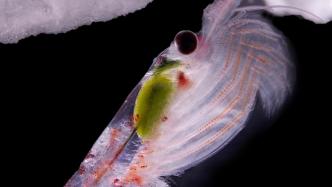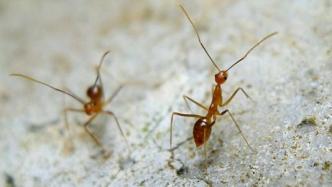
The body length of Antarctic krill is only 3-5 cm, and the weight generally does not exceed 2 grams, but it is the animal with the largest biomass on the earth, estimated to be as high as 300-500 million tons. It also has the largest animal genome sequence ever sequenced on Earth - 48GB in size, 16 times larger than the human genome.
On the evening of March 2, relevant research results were published online in the top international academic journal Cell. This is the first time that the Antarctic krill genome has been fully assembled and sequenced.

The wild animal species with the largest biomass on earth - Antarctic krill.
The title of the paper is "The huge repetitive Antarctic krill genome reveals environmental adaptations and population insights" (The enormous repetitive Antarctic krill genome reveals environmental adaptations and population insights).
Antarctic krill is known as the "sea gold mine" and "sea granary". It is widely distributed, covering the entire Antarctic Ocean, and has tenacious vitality. Severe and long winter, at the same time, likes to live in groups very much. It is the main source of food for whales, seals, fur seals, penguins and other animals, and it is also a key species in the Antarctic ecosystem .

The paper on the first complete deciphering of the Antarctic krill genome was published online on the 3rd.
"This study not only deciphered the genome sequence of Antarctic krill, but also analyzed the molecular mechanism of its important traits, including growth, reproduction, energy metabolism, and extreme environmental adaptability, etc., which provides us with a basis for in-depth understanding of Antarctic krill, and also for The rational development and utilization of Antarctic krill resources provides a theoretical basis." Shao Changwei, co-first author and corresponding author of the article, director of the genome department of the Yellow Sea Fisheries Research Institute of the Chinese Academy of Fishery Sciences, said.
Fan Guangyi, the co-corresponding author of the article and chief scientist of Qingdao BGI Institute, said: "Antarctic krill is an important part of the entire Antarctic food chain, and the deciphering of its genome will not only help us gain a deeper understanding of this important species and the entire Antarctic from the molecular level. It is expected to contribute to the sustainable development of Antarctic fisheries and ecological resources.”
The research was completed by an international research team formed by the Yellow Sea Fisheries Research Institute of the Chinese Academy of Fishery Sciences, the Qingdao Huada Gene Research Institute, the Alfred Wegener Institute in Germany, and the Australian Commonwealth Scientific and Industrial Research Organization. Bettina Meye, a professor at the Alfred Wegener Institute in Germany, is another co-corresponding author of the article.
The researchers assembled and studied the Antarctic krill genome, the largest animal genome reference sequence to date, revealing the molecular basis of Antarctic krill's adaptation to extreme environments and the evolution of population history.
Deciphering the largest animal genome, deciphering extreme environmental adaptations
The genome of Antarctic krill is about 16 times that of the human genome, and has highly repetitive features. Therefore, genome assembly is the biggest challenge hindering breakthroughs in genomics research of this species.
The researchers constructed an Antarctic krill genome sequence of about 48GB, the largest reference sequence of an animal genome to date , 20%-30% larger than the published ultra-large genomes of African lungfish and Australian lungfish.
The researchers found that the repeat sequence content of Antarctic krill was as high as 92.45%, which was derived from the two explosive expansions of the repeat sequence of the Antarctic krill genome. This is also the animal genome with the highest repeat sequence content reported so far, and the proportion of tandem repeat long repeat units is also significantly higher than that of other species.
25 significantly expanded gene families were identified in its genome, and a total of 12 gene families were related to krill molting and energy metabolism.
In summer with relatively high temperature, long light and sufficient food, Antarctic krill has vigorous life activities and quick molt. In winter, the overwintering strategy of Antarctic krill is to use molting for negative growth. Alterations in genes related to molting and energy metabolism are adaptations of Antarctic krill to the unstable food supply in the Southern Ocean. The expression levels of representative genes related to molting and energy metabolism were significantly different in winter and summer.
The researchers also found that some of the genes in the feedback pathway of the Antarctic krill circadian clock - CRY1, CLK, NEMO and PDP1 - showed changes over time - summer (long days) and winter (long nights). The expression level. This suggests that Antarctic krill may have evolved physical adaptations and behavior patterns controlled by the circadian rhythm system, helping them survive in environments with severe changes in light conditions such as low temperature and polar day and night.
Reproductive Isolation vs Same Shrimp
Due to the presence of the Southern Ocean circumpolar current, whether Antarctic krill is a genetically homogeneous population has always been a hot spot of concern.
The research team investigated four areas of high Antarctic krill biomass in the Southern Ocean—South Georgia (SG), South Shetland Islands (SSI), Prydz Bay (PB), and the Ross Sea (RS)— — Collected 75 individuals, identified a total of 365 million SNPs (single nucleotide polymorphisms), and carried out population genetics research. It was found that although they were distributed in different regions, their genetic sequence composition was not significantly different. Antarctic krill have high genetic connectivity over a large geographic range, with no substantial differences among different geographic groups.

Repeated sequences in the Antarctic krill genome underwent two explosive expansions, and 25 significantly expanded gene families were identified.
However, the genetic differentiation of Antarctic krill is still influenced by its environment. The weak population structure of Antarctic krill is due to the natural selection pressure generated by environmental differences in different geographical regions.
Separately, the researchers found that climate change is affecting the size of Antarctic krill populations.
Starting about 10 million years ago, during the Pleistocene period, the climate fluctuated violently during the glacial-interglacial period, the temperature of the Southern Ocean dropped as a whole, and the population of Antarctic krill also decreased sharply.
About 100,000 years ago, the Antarctic krill population rebounded and began to expand. The reason may be that during the Late Pleistocene, cooler temperatures caused the expansion of sea ice habitats, which expanded the krill habitat.
However, the research team also mentioned that although on a large scale, the inferences based on genomic data correspond to historical climate changes, the impact of temperature on Antarctic krill is complex, and it is still difficult to predict the impact of rapid climate change on Antarctic krill. Impact.
Paper link: https://doi.org/10.1016/j.cell.2023.02.005
